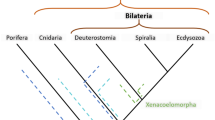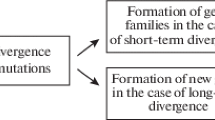Abstract
The importance of evolutionary parallelisms and their differences from evolutionary convergences have been historically underappreciated, as recently noticed in Gould's last book `The structure of evolutionary history'. In that book, Gould make an effort to distinguish and to reinterpret these concepts in the light of the new discoveries of the last decades on developmental biology and genetics, presenting the elegant metaphor of `Pharaonic bricks versus Corinthian columns'. In this paper I will briefly discuss these concepts, and will argue that, despite the advances that have been made to define them in theory, it is rather hard to differentiate them in a practical phylogenetic context. In order to do so, I will provide some few examples from my own empirical studies on the last years of one of the most morphologically and taxonomically diverse groups of Vertebrates, the catfishes.
Similar content being viewed by others
References
R.M.N. Alexander (1965) ArticleTitleStructure and function in catfish J. Zool. (London) 148 88–152
W.E. Burgess (1989) An Atlas of Freshwater and Marine Catfishes: A Preliminary Survey of the Siluriformes TFH Publications Berkshire
M. Chardon (1968) ArticleTitleAnatomie comparée de l‘appareil de Weber et des structures connexes chez les Siluriformes Annales du Musee Royal de l’Afrique Centrale (Tervuren) 169 1–273
R. Diogo (2003) Higher-level phylogeny of Siluriformes: an overview G. Arratia B.G. Kapoor M. Chardon R. Diogo (Eds) Catfishes Science Publishers Inc Enfield 353–384
R. Diogo (2004) Exaptations, Parallelisms, Convergences, Constraints, Living Fossils, and Evolutionary Trends: Catfish Morphology, Phylogeny, and Evolution, a Case Study for General Discussions on Theoretical Phylogeny and Macroevolution Science Publishers Inc Enfield
S.J. Gould (2002) The Structure of Evolutionary Theory Harvard University Press Harvard
E.R. Lankester (1870) ArticleTitleOn the use of the term homology in modern zoology, and the distinction between homogenetic and homoplasic agreements Ann. Mag. Nat. His. 6 34–43
P. Willmer (2003) Convergences and homoplasy in the evolution of organismal form G.B. Müller S.A. Newman (Eds) Oigination Developmental and Evolutionary Biology Bradford Book Cambridge 33–49
O.A. Saether (1983) ArticleTitleThe canalised evolutionary potential: inconsistencies in phylogenetic reasoning Syst. Zoo. 32 343–349
G.G. Teugels (2003) State of the art of recent siluriform systematics G. Arratia B.G. Kapoor M. Chardon R. Diogo (Eds) Catfishes Science Publishers Inc Enfield 317–352
Author information
Authors and Affiliations
Corresponding author
Rights and permissions
About this article
Cite this article
Diogo, R. Evolutionary convergences and parallelisms: &their theoretical differences and the difficulty &of discriminating them in a practical &phylogenetic context. Biol Philos 20, 735–744 (2005). https://doi.org/10.1007/s10539-004-1604-1
Received:
Accepted:
Issue Date:
DOI: https://doi.org/10.1007/s10539-004-1604-1




